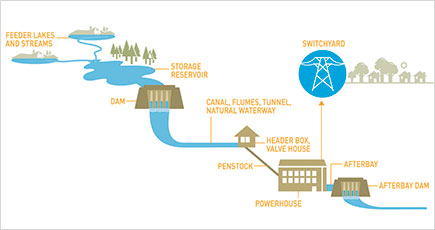Follow these tips when visiting waterways:
- Dams and reservoirs
- Rivers, streams and other waterways
- Canals, flumes and penstocks
Your new pge.com account is almost here! We’re adding easier password resets, improved security and more. Make sure we have your current phone number and email address so you don’t get locked out. Don't get locked out!
Error: Field cannot left blank.
Error: Invalid entry. Do not use equal signs [=] or colons [:].
Error: Field cannot left blank.
Error: Invalid entry. Do not use equal signs [=] or colons [:].
Our hydroelectric system is one of the largest in the country. The system provides clean, renewable energy and offers many recreational opportunities. Reservoirs, dams, rivers and streams are available for swimming, fishing and boating. Campgrounds, picnic areas, boat launches and trails are ready for you to enjoy. Before you visit our recreational areas, take a moment to learn about hydropower and water safety. |
The movement of water rushing from a higher elevation to a lower one produces hydropower. This movement turns a turbine and creates electricity. Dams hold the water, creating reservoirs. Water moves from the reservoirs to powerhouses through waterways, such as rivers and streams. After reaching a powerhouse, the water generates electricity that is transported to the power grid.

Our hydroelectric system:
A hydroelectric system can have large amounts of rushing water present at any time, sometimes without warning. It is important to be cautious around facilities and recognize warning signs.
Although our dams and reservoirs are very safe, an emergency is always possible. When you’re around water that is part of a hydropower system, you must understand emergency warning signs. Know what to do during emergencies.
When you visit a reservoir, river or other body of water, use the following guidelines:
Designed for hydropower production, reservoirs also offer recreational areas for camping, picnicking, boating, fishing and hiking. Be sure to take the following precautions around dams and reservoirs:
Comply with all laws and requirements when boating on a reservoir. Use the following safety guidelines:
Learn more about boating on a reservoir. Visit California State Parks – Division of Boating and Waterways.
Many Northern California waterways are part of a vast hydropower system, with dams located upstream and downstream of the most popular recreational areas. During certain times of the year, sudden changes can occur in water levels and river flows. Heavy rains, melting snow or electric generator use can change a waterway from a slow stream to a raging river in minutes.
Use the following tips to protect yourself and your family in these areas:
Canals, flumes and penstocks move water from one part of the hydropower system to another. Canals and flumes might look inviting, but they can be very dangerous because the amount of water in them can increase quickly. Use the following tips to stay safe near these areas:
Be aware of the following emergency warning signs when you’re in or around water:
When you’re in the water during an emergency, take the following actions:
When you’re near the water during an emergency, take the following actions:
Learn more about water safety in and around our facilities.
©2025 Pacific Gas and Electric Company
©2025 Pacific Gas and Electric Company